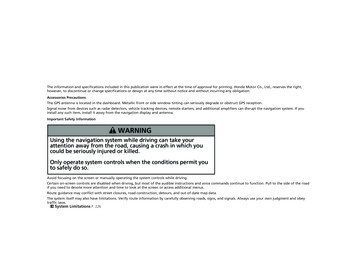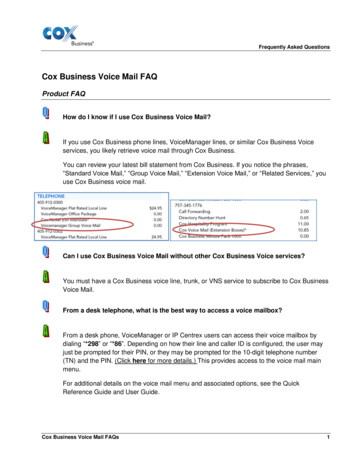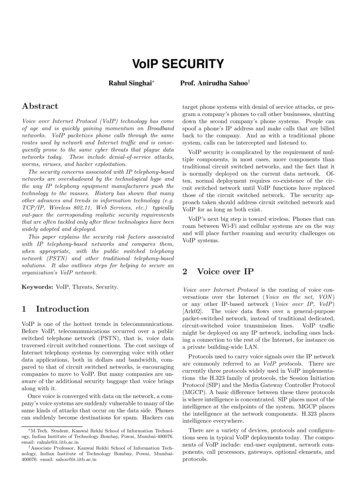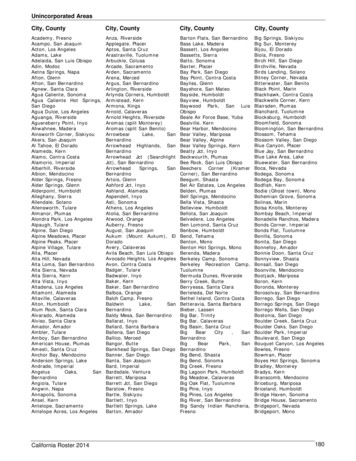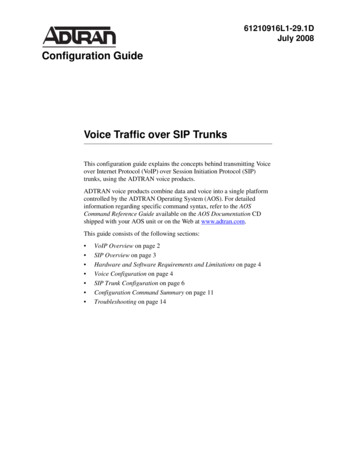
Transcription
INSIDEState School Data What to Look At When Comparing Schools How Choice WorksSPRING 2019A Parent’sGuide toPublicSchoolsPresented by Voice of San Diego inpartnership with UC San Diego Extensionand the San Diego Workforce PartnershipA Run on DualLanguage ProgramsHow Cajon Valley, Vista andSan Diego Unified turned to bilingualimmersion to change their storiesSee every school’s testscores, absenteeism,grad rates, and more!Your questions answered: What is a magnet? Charter?GATE? Choice lottery? How can I get involved in my child’s school? What’s the deal withTransitional Kindergarten?
Volume 2Search our interactive schools mapand find more content online atvoiceofsandiego.org/schools-guide2710372019ON THE INSIDE2YOUR STUDENT,YOUR CHOICE3HOW CHOICE WORKSIN PUBLIC SCHOOLS5SAN DIEGO COUNTYSCHOOL DISTRICTS ANDENROLLMENT WINDOWS67By Scott LewisWHAT IS THAT?By Will HuntsberrySCHOOLS THAT HAVECHANGED THEIR STORIESBy Kayla Jimenez10DATA VS. FEELING: HOW DOYOU JUDGE SCHOOLS?13SAN DIEGO COUNTYPUBLIC SCHOOLS37HOW TO GET INVOLVED INYOUR CHILD’S EDUCATION41SCHOOL VISIT CHECKLIST:KEY QUESTIONS TO ASKWHEN LOOKING AT SCHOOLSBy Will HuntsberrySchool data compiled by UCSan Diego Extension, Voice ofSan Diego and the San DiegoWorkforce Partnership.By Suzy ReidSPRING 2019 VOICE OF SAN DIEGO1
Your Student,Your ChoiceAn annual publication fromVoice of San DiegoEditorsScott Lewis, Laura Kohn, Sara LibbyWritersWill Huntsberry, Kayla Jimenez, Suzy ReidBY SCOTT LEWISData EditorGladys Selfridge, UC San Diego ExtensionSo, your child is starting school or moving up to middle or high school or he or she is in a school you don’t like.Or do you want your child to learnSpanish? French? Mandarin?Do you want to try a new approach to teaching?Are you thinking of moving?You have a choice in whereyour child goes to school.2Project ManagerJulianne MarkowSpanish Language Translation,Publishing and Distribution PartnerDAESVI CUSTOM PUBLISHING(619) 260-8353 daesvi.comFEBRUARY 2019Volume 2CEO & Editor in ChiefScott LewisSome districts are not unified,and they manage just elementaries,just high schools, just TK-8 orjust 6-12 – it’s a hodge-podge.For example, the Chula Vista,San Ysidro, South Bay and NationalSchool Districts are four of those.When kids leave elementaryschools in those districts, theymove on to Sweetwater Union HighSchool District, which runs themiddle schools and high schools inSouth Bay.Within any school district,students can transfer to a newschool that has space. And they caneven transfer out of their district, ifthey meet certain conditions.No matter what, your studentis guaranteed a school to attend:All of our kids are assigned to aneighborhood school by default ifyou don’t make a choice.But beyond the local school,there are a lot of choices and it canget overwhelming. We decidedwe should do what we can tohelp people get a comprehensivepicture of all the public schooloptions, what we know about eachand how the choices work.Read local education news at voiceofsandiego.orgChief Operating OfficerJulianne MarkowManaging EditorSara LibbyAssistant EditorAndrew KeattsAssociate EditorJesse MarxFoundersBuzz Woolley & Neil MorganBoard of DirectorsReid Carr, Olga Diaz, Bob Kelly,Scott Lewis, Eugene “Mitch” Mitchell,Cynthia Morgan-Reed, Bill Osborne,Bob Page, Buzz WoolleyOur MissionTo consistently deliver ground-breakinginvestigative journalism for the San Diegoregion. To increase civic participation bygiving residents the knowledge and in-depthanalysis necessary to become advocates forgood government and social progress.SponsorshipWant to sponsor VOSD? Call today to becomea Community Partner: (619) 325-0525.VOICE OF SAN DIEGO IS ENVIRONMENTALLY RESPONSIBLE.THIS MAGAZINE IS PRINTED ON 20% RECYCLED (10%POSTCONSUMER WASTE) PAPER. ALL INKS USED ARE SOYBASED. OUR PRINTER MEETS OR EXCEEDS ALL FEDERALRESOURCE CONSERVATION RECOVERY ACT (RCRA)STANDARDS. COPYRIGHT 2018 BY VOICE OF San Diego.PHOTO BY ADRIANA HELDIZEveryone in San Diego liveswithin the boundaries ofa school district. Somedistricts are “unified” whichmeans one district runs all thegrade levels and all the schools.San Diego Unified School District,for example, is the largest districtin the region.DesignAshley Lewis
How Choice Worksin Public Schoolsstart here:Are you happy with yourneighborhood school?Neighborhood SchoolyesnoOK, are you looking for atraditional school but aren’tsatisfied with the one inyour neighborhood?Great. Call or stop by the school and ask to enroll. Try to do this in thespring before your child will start school. You’ll have to fill out a lot offorms and prove your child has been vaccinated and that you live inthe area. But you do not need to show proof of U.S. citizenship.Intradistrict TransferyesCheck in this guide to see all the schools in your district. Districts allowyou to request three schools you would like to switch to. If the first oneon your list isn’t available, they’ll give you the second choice and so on.OK, checked. Now?noYou want something else.You may be interestedin a magnet schoolor charter school.Each district has a different deadline for when you must apply totransfer to a different neighborhood school. Careful! In San DiegoUnified, that window for applying is usually in the fall, almost a fullyear before your child would start at the new school. In other districts,it’s in late winter or spring. We’ve compiled what we know about eachdistrict’s deadlines.Magnet SchoolsThese are schools operated by some school districts that have a focuson something like arts or science. Last year, 715 students applied toSan Diego Unified’s School of Creative and Performing Arts and 700got in, for example. You have to meet the same deadlines as if youwere applying for a transfer.Charter SchoolsIMAGE VIA SHUTTERSTOCKSome public schools operate under contract (aka “charter”) with adistrict or the state, and they’re allowed to try different educationapproaches and use customized work arrangements with theireducators. Charter schools all have their own application deadlines.Other DistrictsIn limited circumstances we explain later in the guide, you can apply forschools outside your district.SPRING 2019 VOICE OF SAN DIEGO3
News.Worthy.We give journalism purpose in our region.Turning residents into advocates. Holdingleaders accountable for social progress andgood government. That’s the investigativejournalism that’s worthy to us.voiceofsandiego.orgSubscribe to theMorning Report atvoiceofsandiego.org/morning-report
Compare schools in your district atvoiceofsandiego.org/schools-guideOceanside UnifiedJan. 14-March 29(760) 966-4008San Diego CountySchool Districts &Choice WindowsHere are the deadlines for applying fordifferent schools for the county’s largestdistricts that have many options.Carlsbad UnifiedJanuary-March for K-8January for High School(760) 432-2247Vista UnifiedTentative, third week of February(760) 726-2170Escondido Union HighJan. 9-March 1(760) 291-3281Escondido UnionNov. 5-Feb. 8(760) 432-2247FallbrookUnion HighSan Dieguito Union HighTentative, February(760) 753-6491Encinitas Union ElementaryCardiff ElementaryRancho Santa Fe ElementarySolana Beach ElementaryDel Mar Union ElementaryPoway UnifiedFeb. 1-March 31(858) 521-2840San Diego UnifiedTentative, October-November(619) 260-2410Sweetwater Union HighTentative, February-April(619) 691-5546National ElementaryChula Vista ElementaryTentative, February-April(619) 425-9600South Bay Union ElementarySan Ysidro ElementaryGrossmont Union HighTentative, January-February(619) 644-8082JulianUnion HighDehesa ElementaryCajon Valley Union ElementaryFebruary-March(619) 588-3210La Mesa-Spring ValleyIn-District Transfers: Feb. 1-March 31(619) 644-8000Lemon Grove ElementarySPRING 2019 VOICE OF SAN DIEGO5
Learning the LingoWhat Is That?BY WILL HUNTSBERRYThese are terms you’re likely tohear navigating the educationworld of San Diego County.Choice WindowThis term refers to the dates duringwhich a school district will acceptapplications to attend a school theymanage that isn’t your neighborhoodschool. It doesn’t matter when withinthe window you apply. It’s not firstcome, first served.No matter what school district youlive in, your child will automaticallybe able to enroll in a neighborhoodschool. The choice window existsfor families who want somethingdifferent. In theory, choicewindows allow you to apply to anyneighborhood or magnet school in adistrict. But just because you chooseanother school doesn’t mean you’llget in. The choice windows in eachdistrict work a little differently andat different times. But the generalidea is always the same: Rank severaldistrict schools you might like toattend. If there are open seats at theschool, you’ll be entered in a lotterywith everyone else who wanted oneof those seats. Those who get chosenin the lottery get a seat. The choicewindow is only for schools directlymanaged by the district. If youwant to attend a charter school, ora private school for that matter, youhave to apply directly to that school.Choice Lottery PrioritiesSay a school has five open seats,but 10 students try to choice into thatschool. Before any lottery takes place,students are ranked based on choicelottery priorities. San Diego Unified,for instance, has seven priorities, butsome districts have fewer. Typical6Read local education news at voiceofsandiego.orgpriorities usually include havinga sibling who already attends or aparent who teaches at the selectedschool. Say five of those 10 studentsin our example have a sibling at theschool in question. Those would bethe five who get in.Charter SchoolsCharter schools are public schools– funded by California taxpayers,just like traditional schools. Theyare tuition-free and accessible to allstudents, just like traditional schools.They get approval from a schooldistrict (or the County Office ofEducation or the State of California)to operate for five years. Every fiveyears, they must renew that approval,which is contingent on studentoutcomes and fiscal responsibility.But with their approval, they canoperate independently from theschool district that authorizes them.If the district superintendent doesn’tlike a charter school principal, shecan’t fire the principal. Each charterschool is overseen by its own boardof directors and the vast majorityare nonprofit organizations. Theyhave leeway to try new curricula andapproaches to education that regularpublic schools don’t.You must submit a separateapplication to each charter schoolyou’d like to attend. Each charterschool has its own window foraccepting applications – usually soonafter Jan. 1. Charters are requiredto select students through a lotterysystem. Many people apply to bothtraditional schools they’d like theirstudent to attend and to charterschools – if they are lucky enough toget into more than one school, theypick among them.Magnet SchoolsMagnet schools are managed bydistricts. They are not independentlyoperated, like charter schools. Butthey do try to attract parents andstudents with a theme or specializedcurriculum (think dual-languageMandarin-English program or ascience and technology academy).Magnet schools are often, but notalways, located in historically poorerareas. They are called magnetsbecause the idea is to pull in studentsfrom more affluent areas. If studentscome from many different areas ofa town, they’re more likely to makeup a diverse student body. Theschool will have a mixture of moreaffluent students and students frompoorer backgrounds. In theory, italso provides an education optionfor neighborhood kids who live nearthe school. If you’d like to apply fora magnet school, it’s best to submitan application during your district’schoice window. You can apply anytime, but your chances of gettingin decrease if you apply after thewindow closes.GATEThis is shorthand for giftedand talented education. InSan Diego Unified, every studentis automatically tested for GATEin second grade and fifth grade.Different districts handle thisdifferently, and many don’t offerGATE at all. If a child is acceptedto GATE, the different types ofprograms out there vary wildly.In a few cases, GATE students areoffered a place in an exclusive GATEclass. More often, they’ll be groupedinto a general classroom where asignificant portion of the class is
considered gifted. Usually, these classesare taught by people with a special GATEcredential.Transitional KindergartenSchool starts when a child is 5 yearsold, right? Not necessarily. The oldestone-fourth of 4-year-olds can startschool in a program called transitionalkindergarten, or TK – in most districtsbut not all. Specifically, transitionalkindergarten is for students who turn 5after Sept. 2 but before Dec. 2.For that group of kids, it can be anextra year of school – fully paid for by thestate. Charter schools and high wealthschool districts funded through localtaxes are not required to provide TK,and most do not.Stand-alone TK classrooms are usuallya hybrid of preschool and kindergartencurriculum, but with many more studentsand fewer teachers and toys than a typicalpreschool class. Sometimes TK studentsare served in regular kindergartenclasses, and in that model, the TKstudents will essentially receive the samecurriculum two years in a row.InterdistrictTo attend a public school outside ofyour district, you must complete theSan Diego County Office of Education’sApplication for Interdistrict AttendancePermit Form 341. You can find it online.Districts only allow students to enrollfrom outside district boundaries in a fewcircumstances.If a student moved out of district, butonly had one year left in elementary,middle or high school, he or she canfinish the final year at the old district.Districts may give permits to certainstudents out of district for social oracademic adjustment reasons, including:PHOTO BY ADRIANA HELDIZ If a course or training is available inone district but not in the district ofresidence If the family is planning to changeresidence When it is impossible to arrangeadequate child care or supervision inthe district of residence If a parent or guardian’s place ofemployment is within a differentdistrict than where they resideSchools ThatHave ChangedTheir StoriesBY KAYLA JIMENEZSherman Elementary School students in a dual-languageimmersion class practice their reading skills.Once Avoided, StudentsSwarm to ShermanIn 2008, Sherman Elementaryhad some of the lowest testscores in the San DiegoUnified School District. Thatyear, the school introducedan ambitious dual-languageimmersion program.Today, students at the schoolwith more than 60 percentnon-native English-speakers arelearning English at a faster ratethan others in the district.This year, almost 18 percent ofall students were reclassified asfluent English-proficient basedon assessment scores. Across thedistrict, about 12 to 15 percentof English-learning studentsreclassify.Students at the school learnin one language – English orSpanish – during the first halfof the day, and the secondlanguage in the other. Nearly100 percent of students at theschool come from low-incomefamilies.Nicole Cázeres Enríquez,principal at ShermanElementary, credits the successof the school to the program andinvolvement from the Spanishspeaking community.“I think one of the majorthings is the mindset,” shesaid. “Instead of thinkingof a language-learner ashaving a deficit, we use it as aspringboard for them to learnthe new language.”She said the school has oneof the largest English LanguageSPRING 2019 VOICE OF SAN DIEGO7
Casillas Turnsto ComputersSeveral years ago, the Chula VistaElementary School District set a goalto make sure every student in gradesthree through six had access to alaptop in the classroom.They wanted to make sure thedevices were part of the traditionalcurriculum. It’s working, said ChrisVickers, the principal at CasillasElementary School.“It’s made a big difference,” saidVickers. “Technology is innate for ourstudents so they take to it right away.It furthers their education outside ofgeneral textbooks.”Students at Casillas in these gradelevels are making strides in Englishlanguage arts. The percentage ofstudents performing well on thestatewide assessment for English andI want our studentsto understand theyare coming to schoolnot because theyhave to come, butthat they have a sayin their growth andunderstanding.”language arts has improved from 59percent in 2015-2016 to 77 percentlast year. Reclassification of Englishlanguage learners is up by21 percent.The school credits the growth tocontinual tracking of quantitative andqualitative data from assessmentsthroughout the school year.Vickers said when he arrived atCasillas three years ago, a lot ofthe computers at the school wereoutdated, and he felt there weretweaks and changes to be made tofacilitate students’ academic andsocial growth.“We are now very strategic on whatwe do day in and day out,” he said.“I want our students to understandthey are coming to school notbecause they have to come, but thatthey have a say in their growth andunderstanding.”The school hosts “red-carpet”A student at Joseph Casillas Elementary School works on her class assignments.8Read local education news at voiceofsandiego.orgaward ceremonies each quarter torecognize students for academicachievement alongside members ofthe community, including teachersand parents.A Vista SchoolEmbraces DesignThinkingIn 2014, Vista Unified School Districtturned Washington Middle Schoolinto VIDA, the Vista Innovation andDesign Academy. It’s one of twomagnet schools in the district.“It was time to give a newopportunity in the neighborhoodfor kids,” said VIDA Principal EricChagala.The school uses what’s knownas a design-thinking approachto encourage students to identifyproblems, get diverse groupstogether to brainstorm creativesolutions and then produce aprototype to resolve the issue. Itcould be a letter to a politician, arobot or a video.The incredible transformationof the old Washington Middle tothe new VIDA isn’t without someuncomfortable realities. Thesurrounding neighborhood is almostall Latino, and Washington was oneof the most segregated schools in theregion. Now, the new curriculum hasattracted students from across thedistrict.But neighborhood studentsmust apply for the lottery to get in,just like students from elsewhere.The number of poor students inthe school – as measured by whoqualifies for free and reduced-pricelunch – has fallen dramatically, anddiversity has increased by morethan 30 in the Ethnic-DiversityIndex, from the Education DataPartnership, since 2014. The moreevenly distributed the student body,the higher the number on the index.Today, about 40 percent of its 750students qualify for free and reducedlunch.The California Board Associationhas given VIDA its Golden Bell award –a recognition of outstanding programs– twice in the past five years for use ofdesign-thinking in instruction.VIDA’s curriculum includesPHOTOS BY ADRIANA HELDIZAdvisory Committees in the district.“Any time we offer any sort ofparent workshop, they’re highlyattended,” she said. “It’s definitely apart of the culture since the schoolopened. It’s something that’s integralto the student’s education, andSherman’s taken it very seriously.”The school received a Gold RibbonSchool Award from the CaliforniaDepartment of Education for itslanguage immersion program andfor improving test scores above thedistrict average in 2016.
Students at Vista Innovation and Design Academy show Principal Eric Chagala their latest project.programs like Project Lead The Way,a science, math and technologyprogram offered through corescience and design lab classes. It alsohas a partnership with Qualcommto teach coding and robotics tostudents who are interested in STEM– science, technology, engineeringand math.The board association recognizedVIDA and the district for designingprograms to close the achievementgap. Reclassification of VIDA Englishlearners has grown 10 percent in thelast four years. Last year, 29 percent ofthose students reclassified.Cajon Valley LeansInto LanguagesCajon Valley Union School Districthas seen a surge in enrollment indual-language immersion schoolsand magnet schools in general.It’s been a focus of theadministration and SuperintendentDavid Miyashiro, who is keen onmaking sure each of his schoolsmarkets itself competitively.He has introduced a programcalled “World of Work” into all 27schools. The program pairs studentswith working professionals to helpthem picture what they may dowhen they graduate and how schoolrelates. It’s getting attention fromaround the country as a way toprepare kids for careers and gainfulemployment.“It’s the best organized andimplemented K-8 career educationprogram we’ve seen,” wrote GettingSmart, an agency that analyzes thelatest in education innovations andtechnologies.Bostonia Language AcademyIn 2014, Cajon Valley transformedBostonia from an English-onlycurriculum to a magnet school thatwould immerse students not only inboth English and Spanish but anotherlanguage: computer science. Theschool has doubled in enrollment inthe last two years.In 2018, Bostonia was one of the 287schools recognized as a CaliforniaDistinguished School.In 2017, Bostonia had high mathscores and medium English andLanguage Arts results and both weretrending up even though a majorityof its students were learning Englishand the vast majority (80 percent)came from families with low enoughincomes to qualify for free andreduced-price lunches.Eje AcademiesThirteen years ago, parents in apredominantly low-income area ofEl Cajon were upset by the abruptclosure of their school. They gottogether and formed Eje Academiesand a robust dual-languageimmersion program that has grownto 800 students with the samenumber on the wait list.Eje is a charter school, and itstarts all kids at 90 percent Spanishimmersion, all day, every day. In firstgrade, that shifts to 80 percent Spanishand 20 percent English. It continuesuntil fifth grade, when it is 50 percenteach. Its popularity is further proofof how many parents are seeking outdual-language opportunities.Grades six through eight are scoringhigh and medium for English andlanguage arts and math, respectively.All students participate in amusic program. They have a studentmariachi band, an orchestra and thisyear, they are organizing a symphony.Eva Pacheco, the executivedirector, told us parents are allowedto drop in on any course at anytime. But, in addition, school staffsometimes drop in on parents.“We know all students can learnand it doesn’t matter where they arecoming from, what color they are.They can learn,” Pacheco said.SPRING 2019 VOICE OF SAN DIEGO9
Data vs. Feeling:How Do You JudgeSchools?Friday mornings at Ocean BeachElementary School are a localhappening.A light breeze blows off the waterand early light dusts the courtyard.Parents, students and teachers lingertogether, chatting. The principalmakes a few announcements. A localmusician, whose children haven’tattended the school in years, comesto the center with an acoustic guitarhanging from his neck. He playsthe song he plays every Friday, andeveryone knows the words.“Follow the rules if you wannabe cool;help each other out.Make a good choice,use your words and your voice,10that’s what catching the waveis about ”“Catch the Wave” is full of cheesyclichés, but the ritual singingcontains a simpler and deepertruth: Ocean Beach Elementary isa good school. That starts with theintangible community network thatmaterializes every Friday morning.But it ultimately translates to muchmore than feel-good social events.In recent years, OB Elementary wasranked one of the top 10 schools inthe city for educating disadvantagedstudent groups.But without being there, knowingwhat a good school looks like isn’teasy. For a parent with infinitetime, the best advice is to visit everyRead local education news at voiceofsandiego.orgschool you’re interested in. Visit it atdifferent times. Watch teachers teach.Feel the vibe.But what parent has all that sparetime? That’s where our schools guidecan help. We couldn’t poke our headin every classroom in the county orgo to every courtyard on a Fridaymorning, either. What we can do isprovide data on each school.Data isn’t perfect. This year, wehave updated the guide with moreindicators to help us get closerto a comprehensive picture ofeach school. But it’s important toremember you can’t feel somethinglike the Friday mornings at OBElementary or see a teacher get awhole classroom of kids passionateabout a subject from looking at data.IMAGES VIA SHUTTERSTOCKBY WILL HUNTSBERRY
Here’s What to Look forIt really isn’t all about test scores.And that’s because, looked at ontheir own, test scores sometimesmake a school look better or worsethan it really is. Here’s why: Studentsfrom higher income brackets tend toperform better on tests than studentsfrom lower income brackets. If yousee a school with great test scores, itmay just mean most of the kids thereare well-off. They may have had moreresources growing up, more exposureto books, more time with parents andother educators. It doesn’t necessarilymean the teachers are great.Great teachers close theachievement gap between poor andrich students – and they close theachievement gap for students ofdifferent races, too. The equity ratingwe provide will help you understandhow well a school is doing dealingwith these achievement gaps.Equity RatingThis is one of the most importantfactors to consider. It rates a school onhow well it is closing the achievementgap. For instance, say a school’spopulation is 90 percent affluent and90 percent of its students excel atreading and math. Say the kids whodon’t excel are the same ones whocome from poorer backgrounds. Thatschool would get a low equity rating,because that school really isn’t doinganything particularly special. It isn’tclosing the achievement gap.Test ScoresSure, they’re worthwhile. Ourguide will let you know how eachschool stacks up against theaverage. Also, crucially, it tells youif the scores are trending up ordown.Free and Reduced LunchThis metric is far from perfect.But currently, it is the best dataavailable on how many studentswithin a school are living inpoverty. In a perfect world, thatdata wouldn’t matter. But it does.Schools in very poor communitiestend to get new teachers, whileexperienced teachers transferaway. That high turnover makesit hard to build community andeducate children well – whichultimately reinforces the cycle ofpoverty. That being said, look forschools with high percentagesof students who receive free andreduced lunch that also perform wellon tests. These are amazing schools.Ocean Beach elementary is a greatexample. Even though 58 percent ofstudents qualify for free and reducedlunch, the school still performs wellon tests. It has a stable workforce. It’sa diverse and healthy school.Chronic AbsenteeismLooking at how often students arechronically absent is a great way tounderstand the school’s vibe andatmosphere. Is it a warm, lovingschool, where children want toshow up every day? If it’s not, highpercentages of chronic absenteeismwill be a sign.Look at this metric together withothers. For example, if a school hashigh percentages of poverty, butlow chronic absenteeism, it’s a signthat children feel safe and want tobe there. If the same school’s testscores are low, but trending upward,it’s likely a school in the process ofmaking good things happen. Youshould learn more about it.Special ProgramsWe’ve provided as much data aswe can about which schools havespecial programs like InternationalBaccalaureate or dual-languageimmersion. Interest in dual-languageschools is increasing rapidly, andschool districts are scrambling tomeet demand. If one of those isimportant to you, obviously, factor ithighly into your choice.There is so much more to consider.Does a school have a great dramaor music program? Does it provideafterschool care? Does it have a goodsoccer team? These would all be signsof a good school. But comprehensivedata on this just isn’t available –which is a terrible shame, especiallyin the case of afterschool care. Goingoff limited data points to understandwhether a school is good will alwaysbe imperfect. But they can giveyou a good baseline to know whichschools are worth considering. Andin the absence of unlimited time forresearch, a phone call to the principalwill help.SPRING 2019 VOICE OF SAN DIEGO11
We’re proud tosupportVoice of San Diego .(855) 886-4824Member FDIC
Digging Into the DataSan DiegoCountyPublicSchoolsHow does your schoolmeasure up?The following pages include a list of all schoolsin San Diego County, first organized by district,then by grade level (elementary, middle, highschool). What do all the tables and distinctions mean?Here’s your guide. Voice of San Diego teamed upwith UC San Diego Extension Center for AppliedResearch and Evaluation to compile the data.IMAGES VIA SHUTTERSTOCKKey & DefinitionsEnglish Language Arts (ELA)1:This shows how the school’s studentsperformed on the statewide readingand comprehension test in 2018.Our ratings for this indicator arebased on a five-level rating andcome directly from the state. Theyindicate how a school’s studentsscored compared to the grade levelstandard. If a school ranks “medium”that means its students scored closeto the grade level standard. The“Rating” column factors in how wellthe students performed, combinedwith performance in previous years.The “Trend” column shows only ifa school’s performance increased,maintained or declined compared tothe prior year.English Learners2 : The percent ofstudents in the 2016-2017 schoolyear classified as English-languagelearners.Math1: This shows how studentsperformed against grade levelstandard on the statewide mathtest in 2018. As with ELA, the stateranks schools on a five-level ratingthat shows how well it performedagainst the grade level standard.Again, “Rating” and “Trend” columnsare based on the state’s data just likewith ELA above.Free or Reduced-Price Meals(FRPM)3 : The percent of stude
YOU JUDGE SCHOOLS? By Will Huntsberry 13 SAN DIEGO COUNTY PUBLIC SCHOOLS School data compiled by UC San Diego Extension, Voice of San Diego and the San Diego Workforce Partnership. 37 HOW TO GET INVOLVED IN YOUR CHILD'S EDUCATION By Suzy Reid 41 SCHOOL VISIT CHECKLIST: KEY QUESTIONS TO ASK WHEN LOOKING AT SCHOOLS 3 HOW CHOICE WORKS IN PUBLIC .
